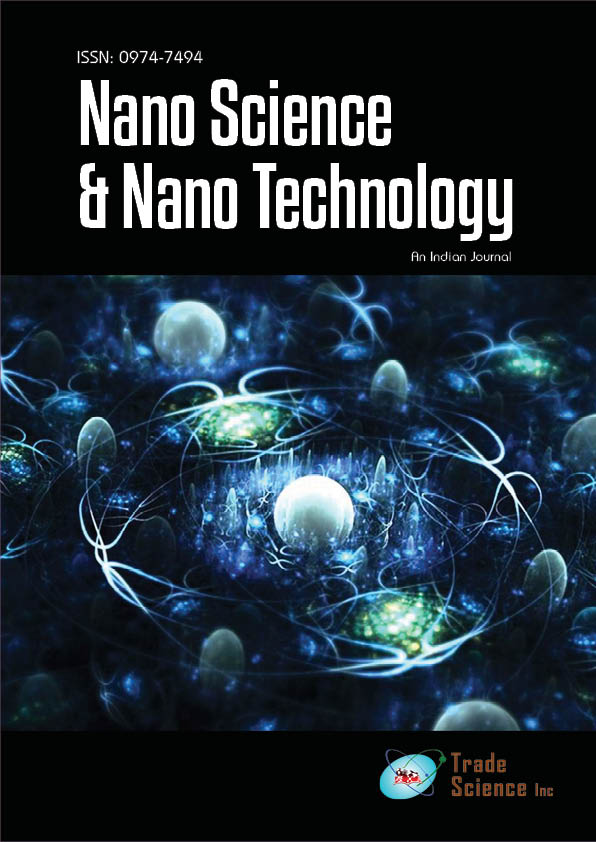Editorial
, Volume: 16( 3) DOI: 2022; 16(3):151Nanoparticles Made by Microbiology and Their Role in Silencing the Biofilm Signaling Cascade
- *Correspondence:
- Skylar StewartEditorial Office, Nanoscience & Nanotechnology: An Indian Journal, UK ; E-mail: info@tsijournals.com
Citation: Stewart S. Nanoparticles Made by Microbiology and their Role in Silencing the Biofilm Signaling Cascade. Nano Tech Nano Sci Ind J. 2022; 16(3):151.
Abstract
The capacity of bacterial cells to adapt to and monitor varied environmental situations is dependent on the density-dependent method of cell-to-cell communication, which is based on contact-associated chemical substance exchange, chemical signaling, and electrical impulse signaling. Biofilm is shown to be the source of the majority of chronic illnesses in people. Biofilm is a syntrophic combination of microbial cells with self-synthesized hydrated polymeric compounds that remain attached to biotic or abiotic surfaces. The formation of biofilm is caused by planktonic bacterial cells adhering to a surface, such as medical equipment and prostheses. Valve endocarditis, chronic otitis media, cystic fibrosis, and wound-associated infections are all complications. Microbiologically manufactured nanoparticles are shown to be more favorable than chemically synthesized counterparts since the former does not require as rigorous requirements as the latter, such as a pure starting material. Microbiologically produced NPs are more economically feasible due to the necessity of ideal conditions and cool temperatures (20–30°C). Furthermore, the inclusion of a biological capping agent on certain micro biogenic nanoparticles, which acts as a protective coating against oxidation, agglomeration, and aggregation, improves stability. As a result, microbiologically produced NPs are frequently regarded as a superior antibacterial treatment alternative.Introduction
The capacity of bacterial cells to adapt to and monitor varied environmental situations is dependent on the density-dependent method of cell-to-cell communication, which is based on contact-associated chemical substance exchange, chemical signaling, and electrical impulse signaling. Biofilm is shown to be the source of the majority of chronic illnesses in people. Biofilm is a syntrophic combination of microbial cells with self-synthesized hydrated polymeric compounds that remain attached to biotic or abiotic surfaces. The formation of biofilm is caused by planktonic bacterial cells adhering to a surface, such as medical equipment and prostheses. Valve endocarditis, chronic otitis media, cystic fibrosis, and wound-associated infections are all complications [1].
Microbiologically manufactured nanoparticles are shown to be more favorable than chemically synthesized counterparts since the former does not require as rigorous requirements as the latter, such as a pure starting material. Microbiologically produced NPs are more economically feasible due to the necessity of ideal conditions and cool temperatures (20°C-30°C). Furthermore, the inclusion of a biological capping agent on certain micro biogenic nanoparticles, which acts as a protective coating against oxidation, agglomeration, and aggregation, improves stability. As a result, microbiologically produced NPs are frequently regarded as a superior antibacterial treatment alternative [2].
Synthesis of microbial nanoparticles
The adjustable physicochemical properties of Nanoparticles (NPs), such as thermal and electrical conductivities, absorption of light, melting point, and enhancement of catalytic activity by altering the surface-to-volume ratio, have recently revolutionized their applicability in the healthcare sector. Nanotechnology refers to the process of creating any-dimensional particles with a variety of form and size-dependent features. Silver Nanoparticles (AgNPs), for example, have a wide range of uses in the healthcare arena, including tumour heating, drug transport, medical imaging, chemical sensors, catalysis, wireless electronic logic, computer transistors, memory chips, and antibacterial activity [3].
Microorganism-assisted nanoparticle synthesis mechanism
Microorganisms have synthesized Nanoparticles (NP) from metals, metal oxides, and metalloids both intracellularly and extracellularly, according to the literature. The extracellular process involves the reduction of metal ions for NP synthesis by microbial enzymes and proteins, bacterial or fungal cell wall components, or organic molecules in the culture medium, whereas the intracellular process involves the initial electrostatic attraction of metal ions by carboxyl groups of the microbial cell wall, resulting in metal ions passing through the cells and reduction by intracellular proteins and cofactors to produce NP. Microbial resistance strategies for cellular detoxification include biochemical systems that include microorganism-mediated nanoparticle production [4].
Enzymatic reduction and/or precipitation of inorganic and hazardous ions in the form of nanostructures affect the solubility of these ions. Extracellular and intracellular bio-catalytic synthesis methods have been postulated, with oxidoreductase enzymes (e.g., NADH-dependent nitrate reductase. Quorum Sensing (QS), a non-cytotoxic bacterial cellular communication system, is the sole way to monitor the growth of sessile populations of bacteria within the biofilm. The effectiveness of any chronic infection treatment depends on developing an effective mechanism for delivering medication molecules to the target cells. NPs have a key function to play in the mechanism of QS inhibition, and so might prevent biofilm development. Autoinducers (AI) such as Acetyl Homoserine Lactone (AHL) and other chemical compounds whose production is reliant on S-adenosylmethionine are used by Gram-negative bacteria to communicate. SAM is an amino acid that is necessary for the production of acyl-homoserine lactones [5]. The presence of SAM is required for the synthesis of N-(3-oxooctanoyl)-L-homoserine lactone in E. coli with plasmid linked lux I, according to a research.
REFERENCES
- Abidi S, H Sherwani, SK Siddiqui. Drug resistance profile and biofilm-forming potential of Pseudomonas aeruginosa isolated from contact lenses in Karachi-Pakistan. BMC Ophthalmol.2013; 13(57):57.
- Abinaya M, Vaseeharan B, Divya M, et al. Bacterial exopolysaccharide (EPS)-coated ZnO nanoparticles showed high antibiofilm activity and larvicidal toxicity against malaria and Zika virus vectors. J. Trace Elem. Med. Biol. 2018; 45:93–103.
- Ahmed E, Kalathil S, Shi L. Synthesis of ultra-small platinum, palladium, and gold nanoparticles by Shewanella loihica PV-4 electrochemically active biofilms and their enhanced catalytic activities. J. Saudi Chem. Soc. 2018; 22:919–29.
- Ali S G, Ansari MA, Sajid Jamal, et al. Antiquorum sensing activity of silver nanoparticles in P. aeruginosa: an in silico study. Silico Pharmacol. 2017;5:12.
- Al Shabib, NA Husain, FM Hassan, et al. Biofabrication of zinc oxide nanoparticle from Ochradenus baccatus leaves: broad-spectrum antibiofilm activity, protein binding studies and in vivo toxicity and stress studies. J. Nanomater. 2018; 8612158.[Google Scholar] [Crossref]

